PFM Crowns vs Zirconia Crowns: Which Is Better for Your Patients?
PFM (Porcelain-Fused-to-Metal) crowns have been successfully used for many years, providing clinicians with reliable and aesthetic restorations. However, in recent years, many dentists have turned to zirconia crowns, especially for single-unit restorations. While PFM may seem outdated, in certain cases, it remains not only appropriate but even superior to other materials.
This article outlines the key differences between Zirconia and PFM crowns, highlighting their strengths, limitations, and ideal indications.
What is a PFM Crown?
A PFM crown (Porcelain-Fused-to-Metal) is a dual-layer restoration made by fusing porcelain over a metal substructure. This unique construction combines the strength of full metal restorations with the aesthetic appeal of all-ceramic options. PFM crowns have evolved over decades, with newer generations of metals and ceramics offering enhanced strength and appearance.
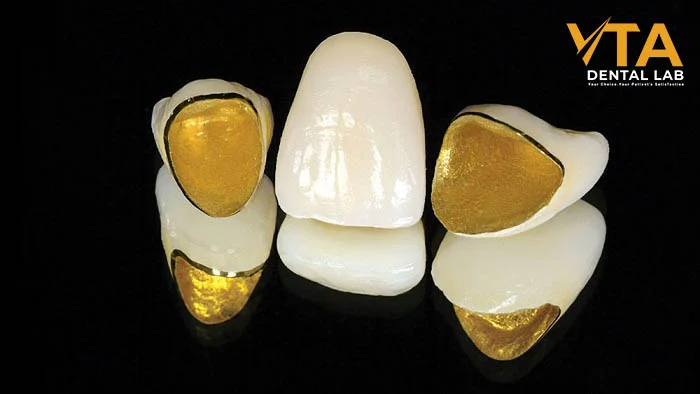
An inside look at the dual-layer structure of PFM Crowns, combining a metal core and porcelain overlay
The metal substructure may be composed of non-precious, semi-precious, or high-noble metals. Non-precious alloys, often referred to as base metals, typically contain less than 25% noble metals and consist mainly of nickel, cobalt, chromium, or beryllium. Semi-precious alloys contain over 25% noble metals. High-noble alloys are composed of over 60% noble metals, including gold, platinum, and palladium, with gold alone making up at least 40% of the mix.
Advantages of PFM Crowns vs Zirconia
PFM crowns are trusted by many dentists for delivering durable and aesthetic restorations over the years. Thanks to their dual-layer construction—featuring a strong metal substructure and a lifelike porcelain exterior—PFM crowns are ideal for various areas of the mouth. They are especially well-suited for long-span bridges or areas requiring additional support. Additionally, PFM crowns are often more cost-effective, making them a budget-friendly option for patients needing restorative treatment.
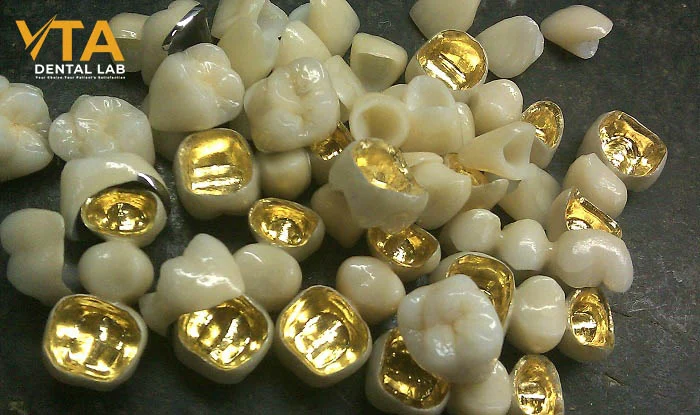
Explore how PFM Crowns vs Zirconia Crowns perform under pressure—durability tested in posterior regions
Disadvantages of PFM Crowns vs Zirconia
Although PFM crowns mimic natural teeth, they do come with limitations. The opaque porcelain layer covering the metal core can appear less natural compared to adjacent teeth. Over time, the metal margin may become visible near the gumline, especially in patients with gingival recession.
Moreover, PFM crowns are not recommended for patients with metal allergies, particularly when non-precious metals are used, as these are more likely to trigger allergic reactions.
What is a Zirconia Crown?
Zirconia crowns are restorations made from highly translucent zirconia—a material that closely mimics the appearance of natural teeth while offering exceptional strength and durability. Full-contour zirconia restorations can be fabricated entirely through digital CAD/CAM workflows, reducing the manual labor involved compared to PFM crowns.

Natural-looking smile restored with Zirconia Crowns—perfect balance of strength and beauty
Unlike PFMs, zirconia crowns are milled from a solid monolithic block, not layered ceramics on a metal base, resulting in a restoration that is both seamless and robust.
VTA offers two types of zirconia crowns: Full Solid Zirconia and Zirconia Multilayer. Full Zirconia restorations are ideal for clinical situations that demand the highest strength material. Zirconia Multilayer restorations offer enhanced aesthetics, designed for cases where a more natural appearance is desired, with slightly reduced hardness.
Both formulations—and zirconia crowns in general—are among the most highly rated restorative solutions available for patients today.
Advantages of Zirconia Crowns vs PFM
Zirconia crowns are at least three times stronger than PFM crowns. They are highly resistant to chipping and wear, making them ideal for patients who grind their teeth or for placement in the posterior region of the mouth.
Zirconia also boasts superior biocompatibility, making it an excellent choice for crowns and bridges, particularly for patients with metal sensitivities, as it is a fully ceramic, non-metallic material.
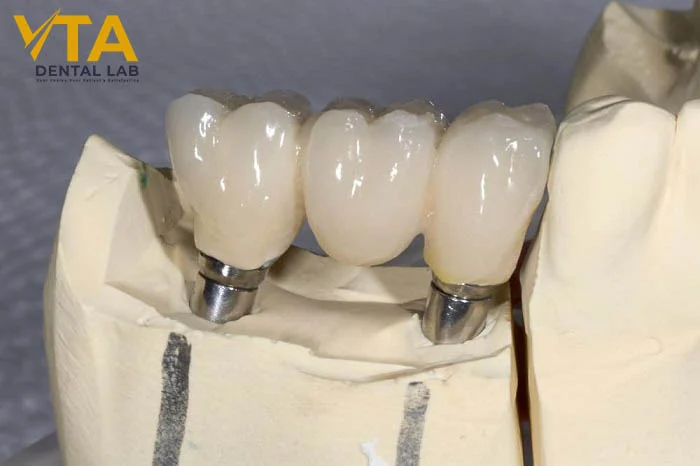
Close-up of full-contour Zirconia Crowns demonstrating lifelike shading and smooth finish
Disadvantages of Zirconia Crowns
One potential downside of zirconia is its extreme hardness, which in rare cases may contribute to wear on opposing teeth, especially in patients with strong bites or bruxism. However, numerous studies have shown that zirconia itself is extremely durable and resistant to fracture, regardless of bite strength.
PFM Crowns vs Zirconia Crowns – Which is better?
When to Use Zirconia Crowns
Zirconia crowns are known for their exceptional durability and strength, making them an ideal choice for posterior teeth, which handle most of the chewing forces. Their high fracture resistance allows for minimal tooth reduction, preserving more of the natural tooth structure and supporting better long-term oral health.
For patients with bruxism or limited occlusal space, full-contour zirconia offers a strong and aesthetic solution that resists wear and cracks.
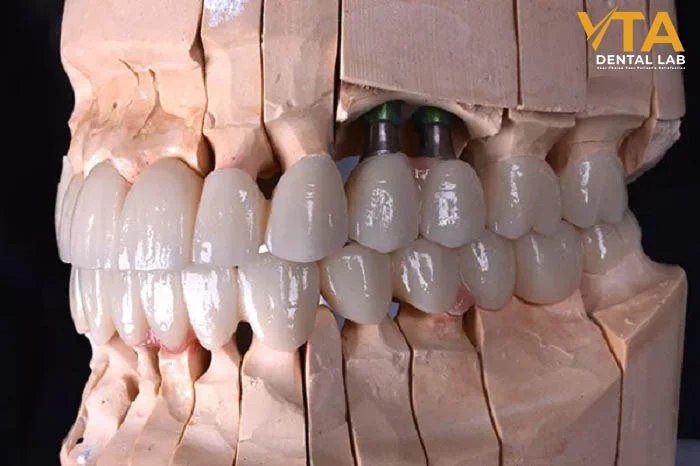
Full-arch restoration using Zirconia Crowns crafted for long-term function and beauty
In terms of cost, zirconia may have a higher initial price than PFM, but due to its long-term durability and reduced need for replacement, it is often more cost-effective in the long run.
From an aesthetic perspective, modern multilayer zirconia provides better translucency and color-matching to natural teeth. Patients also benefit from the absence of metal margins, eliminating the risk of dark lines at the gumline and discoloration over time.
When to Use PFM Crowns
Porcelain-fused-to-metal (PFM) crowns still have a place in certain clinical situations. They’ve been trusted since the 1950s and, when crafted by skilled technicians, can offer decent aesthetics and strength. PFM is also a reliable option for short-span bridges or cases with limited spacing, such as implant-supported restorations with tight occlusal clearance.
However, PFM has limitations:
- Porcelain chipping and fractures are more common under heavy forces.
- The bond between the metal substructure and porcelain can fail over time.
- Lower strength compared to zirconia (porcelain averages ~120 MPa vs. ~900–1400 MPa for full-contour zirconia).
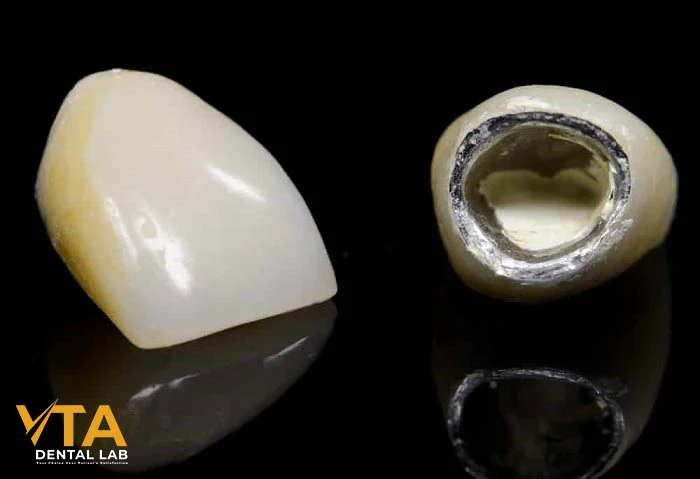
See how PFM Crowns maintain longevity in high-stress occlusal zones over a decade
Which One Should You Choose?
While PFM crowns are still a valid restorative option, zirconia is clearly becoming the preferred material in modern restorative dentistry. It offers superior strength, better aesthetics, and seamless integration into digital workflows—from intraoral scanning to CAD/CAM design and milling.
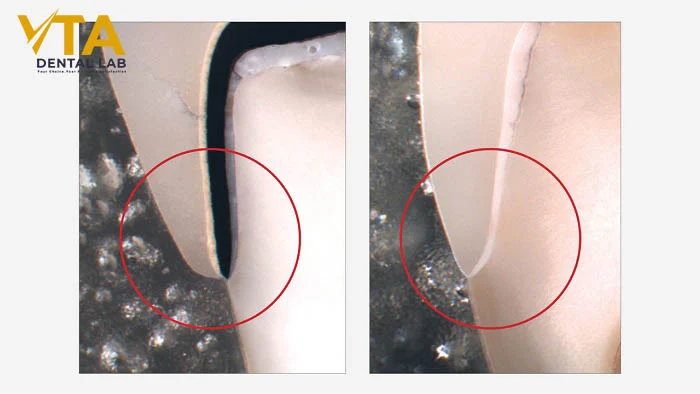
A side-by-side comparison of PFM Crowns vs Zirconia Crowns, highlighting differences in translucency and metal substructure
Zirconia crowns help dental practices by:
- Reducing chair time
- Speeding up turnaround
- Improving long-term outcomes
- Enhancing patient satisfaction
As materials, technology, and lab capabilities continue to evolve, zirconia is quickly becoming the go-to choice for both clinicians and patients. While there are still select cases where PFM may be used, the trend is clear: zirconia is the future of crown restorations.
Conclusion
PFM crowns have served as a reliable tool in dentistry for over half a century and continue to play a vital role in helping patients achieve complete, confident smiles. However, modern materials like zirconia crowns now offer enhanced performance and significantly improved aesthetics, making them a popular and widely used choice for a variety of clinical indications.
As one of the leading dental laboratories in the United States, our highly skilled team is committed to helping you elevate the quality of your restorations and deliver confident smiles to your patients.
Please feel free to contact us for more information. Our experienced technicians are always available to discuss specific cases with you.